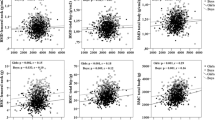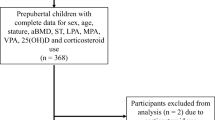Abstract
Summary
The impact of maternal veiling during pregnancy and of socioeconomic status on offspring’s bone mass was investigated in 326 healthy adolescents. Veiling during pregnancy was associated with decreased musculoskeletal parameters in the offspring boys, but not girls. SES was a significant predictor of bone mass in both genders.
Introduction
This study investigates the effects of maternal veiling during pregnancy, a surrogate for low vitamin D level, and socioeconomic status (SES), a surrogate of nutritional status, on their offspring’s bone mass at adolescence.
Methods
Three hundred and twenty-six healthy adolescents aged 13.1(2.0) years and their mothers were studied. The impact of maternal veiling on offspring’s bone mass was evaluated through regression analyses. Outcome variables were bone mineral density (BMD) and content (BMC) at the spine, hip, and total body of the children. Predictors were maternal veiling during pregnancy and SES. Covariates were height, body composition, Tanner staging, calcium intake, vitamin D and exercise in children.
Results
In boys, adjusted analyses revealed that both maternal veiling during pregnancy and SES were significant predictors of bone mass, at multiple skeletal sites. In girls, SES but not maternal veiling during pregnancy was a significant predictor of bone mass at multiple sites.
Conclusion
Maternal veiling during pregnancy was associated with decreased musculoskeletal parameters of boys, but not girls. SES was a significant predictor of bone mass in both genders. These findings may have profound implications on children’s bone health.


Similar content being viewed by others
References
Dawson-Hughes B, Heaney RP, Holick MF et al (2005) Estimates of optimal vitamin D status. Osteoporos Int 16(7):713–716
El-Hajj Fuleihan G, Vieth R (2007) Vitamin D insufficiency and musculoskeletal health in children and adolescents. In: Burckhardt P, Heaney P, Dawson-Hughes B (eds) (2007) Nutritional aspects of osteoporosis 2006. Elsevier B.V., International Congress Series 1297, pp 91–108
Cooper C, Javaid K, Westlake S et al (2005) Developmental origins of osteoporotic fracture: the role of maternal vitamin D insufficiency. J Nutr 135:2728S–2734S
Cooper C, Westlake S, Harvey N et al (2006) Review: developmental origins of osteoporotic fracture. Osteoporos Int 17(3):337–347
Morley R, Carlin JB, Pasco JA et al (2006) Maternal 25-hydroxyvitamin D and parathyroid hormone concentrations and offspring birth size. J Clin Endocrinol Metab 19:906–912
Javaid MK, Crazier SR, Harvey NC et al (2006) Maternal vitamin D status during pregnancy and childhood bone mass at age 9 years: a longitudinal study. Lancet 367:36–43
El-Hajj Fuleihan G, Deeb M (1999) Hypovitaminosis D in a sunny country [Letter to the editor]. N Engl J Med 339:841–842
Ghannage-Yared MH, Chemali R, Yaacoub N et al (2000) Hypovitaminosis D in a sunny country: relation to lifestyle and bone markers. J Bone Miner Res 15:1856–1862
Mishal AA (2001) Effects of different dress styles on vitamin D levels in healthy young Jordanian women. Osteoporosis Int 12:931–935
Saadi H, Nagelkerke N, Benedict S et al (2006) Predictors and relationships of serum 25 hydroxyvitamin D concentration with bone turnover markers, bone mineral density, and vitamin D receptor genotype in Emirati women. Bone 39:1136–1143
Gullu S, Erdogan MF, Uysal AR et al (1998) A potential risk for osteomalacia due to sociocultural lifestyle in Turkish women. Endocr J 45:675–678
Mirsaeid Ghazi AA, Rais Zadeh F, Pezeshk P et al (2004) Seasonal variation of serum 25 hydroxy D3 in residents of Tehran. J Endocrinol Invest 27:676–679
Alagol F, Shihadeh Y, Boztepe H et al (2000) Sunlight exposure and vitamin D deficiency in Turkish women. J Endocrinol Invest 23:173–177
El-Hajj Fuleihan G, Nabulsi M, Tamim H et al (2006) Effect of vitamin D replacement on musculoskeletal parameters in school children: a randomized controlled trial. J Clin Endocrinol Metab 91:405–412
Tanner JM (1978) Physical growth and development. In: Forfar JO, Arneil GC, eds. Textbook of paediatrics. Churchill Livingstone, Edinburgh 249–303
Arabi A, Nabulsi M, Maalouf J et al (2004) Bone mineral density by age, gender, pubertal stages and socioeconomic status in healthy Lebanese children and adolescents. Bone 35:1169–1179
Taylor A, Konrad PT, Norman ME et al (1997) Total body bone mineral density in young children: influence of head bone mineral density. J Bone Miner Res 12:652–655
Suarez F, Zeghoud F, Rossignol C (1997) Association between vitamin D receptor gene polymorphism and sex-dependent growth during the first two-years of life. J Clin Endocrinol Metab 82:2966–2970
Dawson-Hughes B, Harris SS, Krall EA (1997) Effect of calcium and vitamin D supplementation on bone density in men and women 65 years of age and older. N Engl J Med 337:670–676
Arabi A, Mahfoud Z, Zahed L, Maalouf J, Nabusli M, Choucair M, El-Hajj Fuleihan G. Vitamin D receptor gene polymorphisms modulate the musculoskeletal response to Vitamin D supplementation in healthy girls. Oral Presentation. 29th Annual Meeting of the American Society for Bone and Mineral Research, 16–19 September 2007, Hawaii, Honolulu
Walters JR, Balesaria S, Chavele KM et al (2006) Calcium channel TRPV6 expression in human duodenum: different relationships to the vitamin D system and aging in men and women. J Bone Miner Res 21:1770–1777
Heaney RP, Abrams S, Dawson-Hughes B et al (2000) Peak bone mass. Osteoporos Int 11:985–1009
Barr SI, McKay HA (1998) Nutrition, exercise, and bone status in youth. Int J Sport Nutr 8(2):124–142
MacKelvie KJ, Khan KM, McKay HA (2002) Is there a critical period for bone response to weight-bearing exercise in children and adolescents? A systematic review. Br J Sports Med 36(4):250–257
Clark EM, Ness A, Tobias JH, and the ALSPAC Study Team (2005) Social position affects bone mass in childhood through opposing actions on height and weight. J Bone Miner Res 20:2082–2089
Marshall D, Johnell O, Wedel H (1996) Meta-analysis of how well measures of bone mineral density predict occurrence of osteoporotic fractures. BMJ 312(7041):1254–1259
Marwaha RK, Tandon N, Reddy DH et al (2007) Peripheral bone mineral density and its predictors in healthy school girls from two different socioeconomic groups in Delhi. Osteoporos Int 18:375–383
Hind K, Burrows M (2007) Weight-bearing exercise and bone mineral accrual in children and adolescents: A review of controlled trials. Bone 40:14–27
Arafat M (2000) Nutritional Intake of Ca and vitamin D in pregnant women. Master Thesis. Nutrition Department, School of Agriculture, American University of Beirut
Acknowledgments
The study was supported in large part by an educational grant from Nestle Foundation and by a grant from Merck KGaA. The authors thank the administrators, school nurses, parents and students from the American Community School, the International College, Amlieh School and Ashbal Al Sahel School for their support in making the study possible. The authors thank Mrs S. Mroueh for her expert technical assistance in the acquisition and analyses of the bone mineral density scans and Mrs Hajj Shahine for her tireless efforts in running the hormonal assays.
Conflict of interest statement
None
Authors’ contributions All authors participated in the writing of the manuscript and have seen and approved the final version. MN did the literature review, participated in data collection, analysis and manuscript write-up. ZM participated in statistical analysis. JM did the data collection, analysis and participated in drafting of the manuscript. AA participated in patient evaluation, examination and data collection. GEHF was the lead investigator who designed the study protocol, secured funding for the study, oversaw data collection, analysis and contributed substantially to manuscript write-up.
Author information
Authors and Affiliations
Corresponding author
Rights and permissions
About this article
Cite this article
Nabulsi, M., Mahfoud, Z., Maalouf, J. et al. Impact of maternal veiling during pregnancy and socioeconomic status on offspring’s musculoskeletal health. Osteoporos Int 19, 295–302 (2008). https://doi.org/10.1007/s00198-007-0459-0
Received:
Accepted:
Published:
Issue Date:
DOI: https://doi.org/10.1007/s00198-007-0459-0




